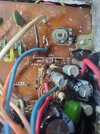The KB262 is a voltage stabilizer diode that contains 2 junctions (the KB362 has 3 junctions). This means the forward voltage drop of a single KB262 will be higher than a single 1N4148. For each KB262, you would need roughly two 1N4148's.
The choice of diode (voltage drop) there depends on the capacitance/volt on the varactors, and the capacitance needed depends on the crystal and tuning requirements. Not every radio is the same there.
The best thing to do when a diode is missing in that spot is to try to figure out what was there originally (voltage drop wise) and find a replacement based on that requirement while trying to stick with a part having similar If (forward current) vs Vf (forward voltage drop).
Mouser has surface mount stabilizers in stock, and what I would recommend is the CMXSTB400. It is a 6 pin dip and contains 4 silicon diodes in series with each junction tapped so you could choose what voltage drop you want for that application.
The choice of diode (voltage drop) there depends on the capacitance/volt on the varactors, and the capacitance needed depends on the crystal and tuning requirements. Not every radio is the same there.
The best thing to do when a diode is missing in that spot is to try to figure out what was there originally (voltage drop wise) and find a replacement based on that requirement while trying to stick with a part having similar If (forward current) vs Vf (forward voltage drop).
Mouser has surface mount stabilizers in stock, and what I would recommend is the CMXSTB400. It is a 6 pin dip and contains 4 silicon diodes in series with each junction tapped so you could choose what voltage drop you want for that application.
Last edited:


